Ancient Greek Gemstone Jewelry
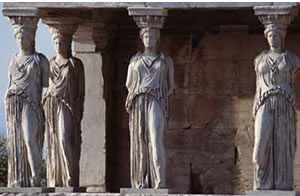 Ancient Greece is called "the birthplace of Western civilisation". About 2500 years ago, the Greeks created a way of life that other people admired and copied. Ancient Greece is called "the birthplace of Western civilisation". About 2500 years ago, the Greeks created a way of life that other people admired and copied.
Jewelry was popular in ancient Greece and the Greeks started using gold and gems in jewelry in 1600 BC, although beads shaped as shells and animals were produced widely in earlier times.
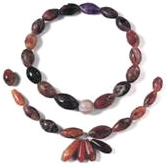 Ancient Greek necklace with beads of agate, sard and amethyst in assorted shapes. From Chamber Tombs 518 and 519 at Mycenae. (Athens, National Archaeological Museum, 6521, 6435). 14th - 13th century BC.
Ancient Greek necklace with beads of agate, sard and amethyst in assorted shapes. From Chamber Tombs 518 and 519 at Mycenae. (Athens, National Archaeological Museum, 6521, 6435). 14th - 13th century BC.
Gems were imported into Greece from every location along the ancient Silk Road, from Asia Minor to the Indian Subcontinent, Sri Lanka, and the Far East. These jewels included such exotic materials as emerald, ruby and sapphire, as well as semi-precious gems from the Middle East, Egypt, and North Africa.
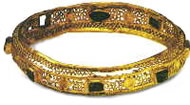 Ancient Greek Gold bracelet decorated with perforations (a technique known as opus interassile) and precious stones (Paris, Cabinet des Medailles). Ancient Greek Gold bracelet decorated with perforations (a technique known as opus interassile) and precious stones (Paris, Cabinet des Medailles).
By 300 BC, the Greeks had mastered making colored gemstone jewelry and were using amethysts, pearls, and emeralds. With the advent of new stone carving techniques gems were now being engraved with intricately designed patterns, and the first signs of cameos appeared, with the Greeks creating them from Indian sardonyx, a striped brown pink and cream agate stone. Greek rings were accented with bezel-set carved glyptic seal-stones or other semi-precious stones, and used with hot wax to seal important documents. The Greeks were the first to use the cameo or intaglio; they were mostly using oval and round-cut cabochon gems.
This would carry over to the emerging Roman culture in the west and by 27 BC, Greek designs were heavily influencing Roman culture.
A pair of ancient Greek gold bracelets with cut-out vine leaves, volutes and set with garnets, amethyst and enamel. From Palaiokastro, Thessaly. (Athens, National Archaeological Museum, XP. 939). 1st century BC.
Greek jewelry was often less intricate than that of other cultures, with simple designs and workmanship. However, as time progressed, the designs grew in complexity.
Bracelets were often worn in pairs or in matched sets. Pieces were usually inlaid with pearls and dazzling gems such as emerald, garnet, carnelian, banded agate, sardonyx, chalcedony, and rock crystal.
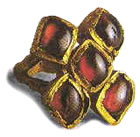 Ancient Greek gold ring with chalecedony gemstones (Paris, Musee de Louvre). Ancient Greek gold ring with chalecedony gemstones (Paris, Musee de Louvre).
Popular designs for earrings included airborne winged figures, such as Eros, Nike, and the eagle of Zeus carrying Ganymede up to Mount Olympus.
Greek jewelry designs were influenced by other cultures and places, such as Asia, due to Alexander the Great. Alexander dramatically expanded the empire, and assimilation brought about significant changes in the style of Greek jewelry.
The extensive use of colored gemstones, such as amethyst, chalcedony, carnelian, garnet, pearls, peridot, ruby and rock crystal took place during the Hellenistic age. Different types of jewelry were now being produced and women wore earrings, bracelets, necklaces, pendants, pins, armbands, thigh bands, finger rings, wreaths, diadems and other elaborate hair ornaments
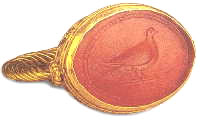 Ancient Greek bezel design gold ring engraved with a bird motif (British Museum). Ancient Greek bezel design gold ring engraved with a bird motif (British Museum).
The ancient Greeks believed that the amethyst held many powers, among them protection against intoxication. The word amethyst comes from the Greek word "amethystos," meaning sober. In ancient Greece, the gemstone was associated with the god of wine, and it was common practice to serve this beverage from amethyst goblets in the belief that this would prevent overindulgence. Even today, amethyst is considered a stabilizing force for those struggling to overcome addiction.
Ancient Greek necklace of gold wire, pearls, amethyst and green glass beads, and gilded silver earrings from Epirus (Athens, Benaki Museum).
Sapphires are named after the Greek word "sapphirus", meaning blue, Sapphires have long been a favorite among priests and kings, Greek included, who considered them symbolic of wisdom and purity.
Evidence suggests that men in early Greece wore jewelry too, but by the fourth century, for reasons long since forgotten, it appears that the trend had ended.
We hope you've found this article interesting. Why not email us with your thoughts or any questions? We always like to hear from our customers.
Contact us |
